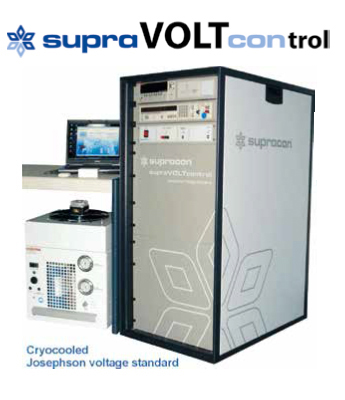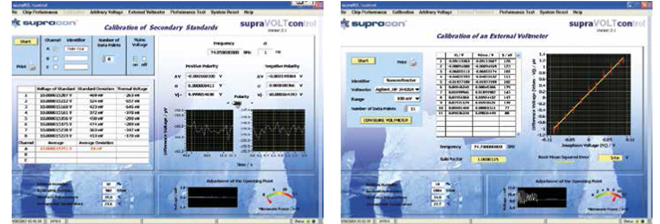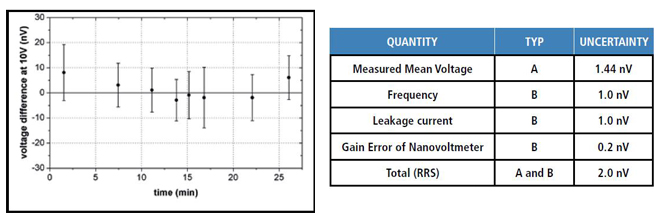Operation and accuracy of an automated cryocooler-based 10 Volt Josephson Voltage Standard System
INTRODUCTION
Josephson voltage standard systems based on arrays of altogether 19,700 SIS Josephson tunnel junctions
are commonly used as primary DC voltage standards. Applying them, secondary voltage standards as well as high precision digital voltmeters can be calibrated with the highest level of accuracy. Further developments are focused on a cryogenic-free operation
[1, 2] and on programmable Josephson arrays
[3, 4]. Because programmable Josephson arrays are difficult to manufacture at the 10 V level and in addition require an expensive control electronics the SIS Josephson voltage standard systems are still attractive, in particular due
to the advantage of the availability of zero current steps.
The system was developed to be easy to use and to avoid a manual control of the Shaprio steps. In the
following we describe the performance of the fully automated 10 Volt Josephson voltage standard system “supraVOLTcontrol” suitable for all DC voltage calibrations. A direct comparison to a helium based system showed an agreement of 1.3 nV at a relative uncertainty of 2×10
-10.
 Figure 1: Photograph of "supraVOLTcontrol"
Figure 1: Photograph of "supraVOLTcontrol"
SETUP OF THE SYSTEM
The Josephson voltage standard system “supraVOLTcontrol” in the cryocooler version is shown in Figure 1. A pulse tube cooler delivered from the Transmit GmbH Giessen was used to establish the chip operating temperature of about 4K. The cryocooler itself produces a cooling power of about 180 mW at the cold stage. To reduce the thermal heat to the cold stage a 75 GHz dielectric microwave waveguide
[2] were used for microwave transmission. The first and second stage of the cryocooler are thermally shielded and placed in a vacuum chamber. The chip itself is magnetically shielded by a cryoperm tube. This protection is required against earth magnetic field and the disturbances issued from the magnetic phase transition of the material located in the regenerator of the cryocooler.
A box including LC filters was installed on the top of the cryocooler to reduce the noise level introduced by the bias electronics and the device under test. Careful grounding was necessary to reduce additional electrical noise from the compressor unit.
A good thermal coupling of the Josephson junction array (JJA)
[5] to the cold stage is important in order to avoid a chip overheating. A thermal interface balances the different thermal expansion coefficients of the copper cold finger and the silicon chip.
Standard 4 K cryocoolers show temperature oscillations of about 0.2 K at the compressor cycling frequency. By the use of a nickel erbium plate, a material with a relative high thermal capacity at 4 K, the temperature oscillation could be reduced to 5 mK resulting in a stable operation.
The microwave with a frequency of 75 GHz is provided by a Gunn oscillator which is stabilized via the PLL of a 578B EIP counter. The microwave power is adjusted automatically to its optimum by a voltage controlled attenuator depending on the required Josephson output voltage.
The JJA is controlled by a μController electronics. A current source drives an AC current through the JJA and in parallel two 16 bit DACs as a voltage source adjust a course and fine voltage. In series to the voltage source a 100 Ω resistor is used for the step selection. With increasing microwave power Shapiro steps appear with a step number given by the voltage of the DACs and the resistor characteristic. The operating point of the JJA is found when the voltage drop at the resistor becomes constant (± 100μV). The difference voltage of
the JJA and a connected voltage standard is read out by a Keithley 2182A which acts as a null detector. In general the chosen voltage difference is smaller then 240 μV and 1 μV in the case of a direct comparison, respectively. A small difference voltage ensures a marginal influence of the gain error of the null detector. The JJA is disconnected from the bias electronics as well as from ground during the readout of the null detector.
The system can automatically calibrate secondary voltage standards as well as the most common digital voltmeters which is shown in Figure 2, in a fast and highly accurate manner. For example the typical time for the calibrating a Fluke 732A with 20 points each in plus and minus polarity is only 30 s. For the measured DVMs the gain factor and nonlinearity will be specified.
 Figure 2: Graphic User Interface
Figure 2: Graphic User Interface
DIRECT COMPARISON
A direct comparison between the cryocooler based system to a Liquid helium based system was carried out at a voltage level of 10 V in order to verify their accuracy. One system provided the Josephson voltage at 10 V and the second system measured this voltage. Both systems were driven at the same frequency of 74.7 GHz stabilized and phase locked to a GPS synchronized
10 MHz reference frequency. In order to avoid unwanted interferences of the systems during adjustment the Shapiro steps only one JJA was connected to its bias electronics and to ground, the other JJA was floating.
 Figure 3: Direct Comparison of two Josephson Systems; Table 1: Uncertainty budget for a direct Josephson comparison
Figure 3: Direct Comparison of two Josephson Systems; Table 1: Uncertainty budget for a direct Josephson comparison
The results of the direct comparison are shown in Figure 3. Altogether eight measurements were made in about ten minutes. The error bars denote the standard deviation of the mean value of a single plus-minusmeasurement with 20 points for each polarity. The result of the direct comparison is a difference of 1.3 nV at 10 V.
The combined standard uncertainty includes type A and type B components from both Josephson systems and is listed in Table 1. The experiments demonstrate an accuracy of the supraVOLTcontrol systems better than 2×10
-10.
M. Starkloff, G. Wende, M. Meyer
Supracon AG, An der Lehmgrube 11, 07751
Jena, Germany,
starkloff@supracon.com
S. Anders, H.-G. Meyer
Institute of Photonic Technologies (IPHT),
P.O.Box 100239, D-07702 Jena, Germany
M. Schubert
Physikalisch-Technische Bundesanstalt (PTB),
Bundesallee 100, 38116 Braunschweig, Germany
Y.-H. Tang, R.T. Hunt, R. Robertazzi, M.A. Fisher, J. Coughlin, R. Patt, E.K. Track, E. Potenziani, “Cryocooled Primary Voltage Standard System,” IEEE Trans. Instrum. Meas., vol. 46, pp. 256-259, 1997.
[2] G. Wende, M. Schubert, T. May, L. Fritzsch, H.-G. Meyer, G. Thummes, Y. Kücükkaplan, L.M. Qiu, J. Kohlmann, J. Niemeyer, H. Hofmeister, and J. Scheerer, “Josephson Voltage Standard Circuit Operation with a Pulse Tube
Cooler,” IEEE Trans. Appl. Supercond., vol. 13, pp. 915-918, 2003.
[3] C. A. Hamilton, S. P. Benz, C. J. Burroughs, and T. E. Harvey, “SNS Programmable Voltage Standard”, IEEE Trans. Appl. Supercond., vol. 7, pp. 2472-2475, 1997.
[4] R. Behr, L. Palafox, G. Ramm, H. Moser, J. Melcher “Direct comparison of Josephson waveforms using an AC quantum voltmeter”, IEEE Trans. Instrum. Meas., vol. 56, pp. 235-238, 2007.
[5] M. Schubert, T. May, G. Wende, L. Fritzsch, and H.-G. Meyer, “Coplanar strips for Josephson voltage standard circuits”, Appl. Phys. Lett., vol. 79, pp. 1009-1011, 2001.
« back
Contact us
Supracon AG
An der Lehmgrube 11
07751 Jena
Germany
Tel.: +49-3641-2328100
Fax.: +49-3641-2328109
info(at)supracon.com



